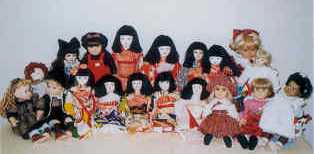"Friendship Doll Mission"
|
During World War II, the above statement was shown in front of the "Miss Kagawa" Friendship Doll display at the North Carolina State Museum of Natural Sciences. During this period in Japan, most of the 12,378 Friendship Dolls from America were burned in front of children, stabbed with spears, and destroyed since they were considered to be "Friendship Dolls wearing masks of the enemy country." Only about 300 of them survive today. Overcoming Bitter Memories I was reading the above statement on a placard, now brownish, when I visited the North Carolina State Museum of Natural Sciences in July 1997. When Miss Kagawa was brought out from the storeroom, I met her. I then deeply felt the good will of humans, as well as their foolishness and weaknesses.
Five years before, in 1992, a phone call from Mr. Shigeo Imaoka, a journalist at the Shikoku Newspaper Company in Kagawa, started my relationship with the dolls. In 1927, a Friendship Doll named Anama Julie had been sent to Japan from Orlando, USA, which is the sister city of Urayasu, where I live. The doll exists in Kagawa Prefecture, and the caller asked me to search for the sender of the doll. The more I studied the history of the Friendship Dolls, the more I strongly felt the importance of peace and international relations, and the need and desire to do something about it. Fifty years after the war, in 1995, at the 5th Anniversary of Urayasu-Orlando Sister Cities, Anama Julie's homecoming to Orlando and the commencement of a new Friendship Doll Mission were announced. With thoughts of Dr. Gulick's 1927 Friendship Doll Mission, we vowed never to repeat war and we commenced a movement to send dolls to children worldwide with the formation of the Urayasu Friendship Doll Exchange Association. Ichimatsu dolls are made from committee members' kimonos or from kimonos donated by others, and Urayasu residents themselves fly across the Pacific Ocean and hand over the dolls. Today, at Urayasu Junior High School, as a part of international understanding education, students make hand-made dolls, kimonos, and passports; attach letters; and send the dolls. It is such a pleasure the movement has also spread to the younger generation since they are the ones responsible for peace in the 21st century. The movement will continue this year, and I am full of appreciation to the teachers and all the other persons concerned. Within these five years, twenty Friendship Dolls made by Urayasu citizens and students have been sent to the United States and to Canada. Ten "Dolls of Gratitude" have been sent to us in return. Gradually, the circle of the Friendship Dolls is expanding. Mutual Homecoming of Dolls The ceremony of Anama Julie's homecoming to Orlando was held at the City Council Chamber in August 1995. The three major American television stations broadcasted this event nationwide. It was an inspiring moment when I deeply felt the importance of each person developing a feeling of peace and friendship that is clearly understood and communicated.
The success of Anama Julie's homecoming led the people of Kagawa to desire the homecoming of Miss Kagawa, the historical Friendship Doll that had been displayed throughout World War II. I was to help arrange this as well, and I met Miss Kagawa in 1997 in North Carolina. This was realized due to the kindness of the Museum's director, Dr. Betsy Bennett. In 1998, we ourselves remarkably brought Miss Kagawa home to Japan. For about a year, Miss Kagawa met many people through restoration and commemorative events, and this led to the formation of a new movement, the Kagawa Prefecture Friendship Doll Association. Miss Kagawa returned safely to the U.S., where she was to be displayed forever at the remodeled museum. Today, we can at any time meet Miss Kagawa, the Japan-US peace envoy. Urayasu and Orlando, in 1999-2000, celebrated its 10th anniversary as sister cities. One of the themes was the Friendship Doll Exchange. The dolls sent to Orlando children from Urayasu made a homecoming to Urayasu with the mayor of Orlando. These dolls met the dolls that had been sent from Orlando to Urayasu. Of course, students and many city residents who made the dolls participated in the exchange on account of the dolls. I have never felt so strongly the importance of peace as at this moment. The exchange program could take place because peace existed. Later, all the Friendship Dolls, along with 200 Urayasu citizens, attended a ceremony in Orlando. The dolls then returned to their own schools, and they are loved by children as symbols of peace. The law to end Japanese immigration was passed by Congress in 1924. Dr. Sidney L. Gulick, who was concerned about the relationship between Japan and the US, began the "Friendship Doll Plan" in 1926-27. This plan has been renovated, and it will continue on into the 21st century. From all over Japan, this sort of movement is spreading out gradually into the world. The desire for peace, which began as an appeal to the public by one person, has surely established a link into the 21st century. Return to Urayasu Friendship Doll Mission |

